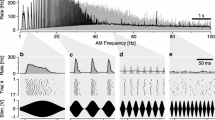Summary
-
1.
The D neuron is one of several auditory interneurons which descend from the prothoracic ganglion in the ventral nerve cord of the cricketTeleogryllus commodus and is characterised by the response properties below.
-
2.
The D neuron has two sensitivity peaks — at 4 kHz (near the conspecific song frequency) and at 900–1,000 Hz. At 4 kHz the ipsilateral intensity-response curve of the D neuron is sigmoid with a dynamic range of 15 dB.
-
3.
The D neuron encodes stimulus durations of up to 80 ms with increases in both the duration of the response and spike numbers per response; but with longer stimulus durations the number of spikes in each response declines. The D neuron follows pulses presented at biologically relevant rates and may therefore provide information on temporal characteristics of the species' song.
-
4.
Directional sensitivity in the D neuron is a maximum at 4 kHz and there is no directional response at 900–1,000 Hz. At low intensities the directivity pattern plotted on polar coordinates is cardioid, with a maximum sensitivity at 90‡ on the ipsilateral side; but at high intensities the response becomes omnidirectional.
-
5.
Removal of contralateral neural input results in a small but consistent reduction in sensitivity to ipsilateral and contralateral sound over a narrow frequency band around 4 kHz. At suprathreshold intensities, however, ipsilateral spike numbers decrease and contralateral spike numbers increase, with the effects becoming more apparent at high intensities. Both excitatory and inhibitory inputs across the ganglion determine the response. The directionality of the D neuron is abolished when the prothoracic tracheal system is blocked, but the tuned response is not affected.
-
6.
Simultaneous recording of the D neuron, and S and L neurons in the ascending auditory pathway, shows that auditory thresholds, spike numbers to a given stimulus, and intensity-response characteristics are different in each neuron. The D neuron is not the posterior projection of S or L neurons.
Similar content being viewed by others
Abbreviations
- T D :
-
threshold of D neuron
- SPL :
-
sound pressure level in dB re. 2·10−5N/m2
References
Ball, E.E., Hill, K.G.: Functional development of the auditory system of the cricket,Teleogryllus commodus. J. comp. Physiol.127, 131–138 (1978)
Bentley, D.R.: Intracellular activity in cricket neurons during the generation of behaviour patterns. J. Insect Physiol.15, 677–699 (1969)
Bentley, D.R.: Control of cricket song patterns by descending interneurons. J. comp. Physiol.116, 19–38 (1977)
Boyan, G.S.: Coding of directional information by a descending interneuron in the auditory system of the cricket. Naturwissenschaften65, 212–213 (1978)
Boyan, G.S.: Directional responses to sound in the central nervous system of the cricketTeleogryllus commodus (Orthoptera: Gryllidae). I. Ascending interneurons. J. comp. Physiol.130, 137–150 (1979)
Burrows, M., Rowell, C.H.F.: Connections between descending visual interneurons and metathoracic motoneurons in the locust. J. comp. Physiol.85, 221–234 (1973)
Dambach, M.: Vibrationssinn der Grillen. I. Schwellenmessungen an Beinen freibeweglicher Tiere. II. Antworten von Neuronen im Bauchmark. J. comp. Physiol.79, 281–324 (1972)
Hill, K.G., Boyan, G.S.: Sensitivity to frequency and direction of sound in the auditory system of crickets (Gryllidae). J. comp. Physiol.121, 79–97 (1977)
Kutsch, W.: Neuromuskulare Aktivität bei verschiedenen Verhaltensweisen von drei Grillenarten. Z. vergl. Physiol.63, 335–378 (1969)
Kutsch, W., Huber, F.: Zentrale versus periphere Kontrolle des Gesanges von Grillen (Gryllus campestris). Z. vergl. Physiol.67, 140–159 (1970)
Kutsch, W., Otto, D.: Evidence for spontaneous song production independent of head ganglia inGryllus campestris. J. comp. Physiol.81, 115–119 (1972)
Leroy, Y.: Exemple d'espèces cryptiques distinguées par leurs émissions acoustiques (Teleogryllus commodus Walk.,Teleogryllus oceanicus Le Guillou, Gryllinae, Orthoptères Ensifères). C.R. Acad. Sci. Paris260, 5343–5346 (1965)
O'Shea, M., Rowell, C.H.F., Williams, J.L.D.: The anatomy of a locust visual interneurone; the descending contralateral movement detector. J. Exp. Biol.60, 1–12 (1974)
Otto, D.: Untersuchungen zur zentralnervösen Kontrolle der Lauterzeugung von Grillen. Z. vergl. Physiol.74, 227–271 (1971)
Rehbein, H.G.: Experimentell-anatomische Untersuchungen über den Verlauf der Tympanalnervenfasern im Bauchmark von Feldheuschrecken, Laubheuschrecken und Grillen. Verh. Dtsch. Zool. Ges.66, 184–189 (1972)
Rheinlaender, J., Kalmring, K.: Die afferente Hörbahn im Bereich des Zentralnervensystems vonDecticus verrucivorus (Tettigoniidae). J. comp. Physiol.85, 361–410 (1973)
Rheinlaender, J., Kalmring, K., Römer, H.: Akustische Neuronen mit T-Struktur im Bauchmark von Tettigoniiden. J. comp. Physiol.77, 208–224 (1972)
Rheinlaender, J., Kalmring, K., Popov, A.V., Rehbein, H.: Brain projections and information processing of biologically significant sounds by two large ventral-cord neurons ofGryllus bimaculatus De Geer (Orthoptera, Gryllidae). J. comp. Physiol.110, 251–269 (1976)
Young, D., Ball, E.: Structure and development of the auditory system in the prothoracic leg of the cricketTeleogryllus commodus (Walker). I. Adult structure. Z. Zellforsch.147, 293–312 (1974)
Zaretsky, M.D., Eibl, E.: Carrier frequency-sensitive primary auditory neurons in crickets and their anatomical projection to the central nervous system. J. Insect Physiol.24, 87–95 (1978)
Zhantiev, R.D., Chukanov, V.S.: Reaction of the auditory system ofGryllus bimaculatus (Orthoptera, Gryllidae) to intraspecific sound signals. Zool. Zh.51, 983–993 (1972)
Zhantiev, R.D., Kalinkina, I.N.: Sound reaction of descending neurons in abdominal part of the central nervous system of Orthoptera. Nauch. Dokl. Vyss. Shkoly. Biol. Nauk.8, 66–71 (1977)
Zhantiev, R.D., Korsunovskaya, O.S.: Reaction to sound of descending neurons in cervical connectives of the cricketGryllus bimaculatus Deg. (Orthoptera, Gryllidae). Entomol. Obozr.56, 248–257 (1977)
Author information
Authors and Affiliations
Additional information
I thank Drs. E.E. Ball, K.G. Hill and G. Stange for critical comments.
Rights and permissions
About this article
Cite this article
Boyan, G.S. Directional responses to sound in the central nervous system of the cricketTeleogryllus commodus (Orthoptera: Gryllidea). J. Comp. Physiol. 130, 151–159 (1979). https://doi.org/10.1007/BF00611049
Accepted:
Issue Date:
DOI: https://doi.org/10.1007/BF00611049




